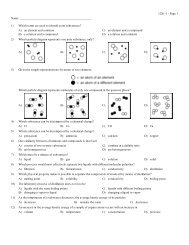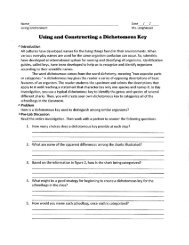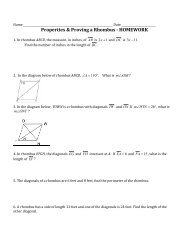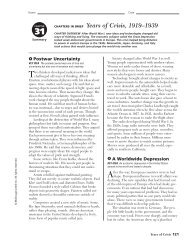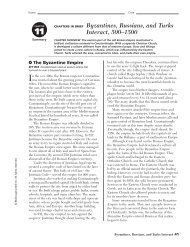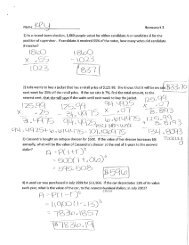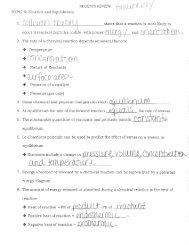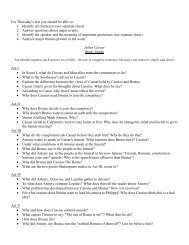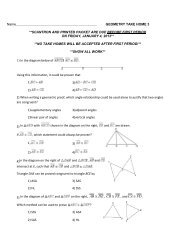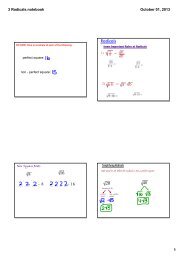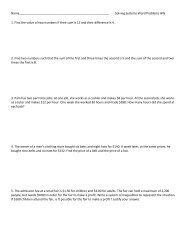Chap 24 handout
Chap 24 handout
Chap 24 handout
Create successful ePaper yourself
Turn your PDF publications into a flip-book with our unique Google optimized e-Paper software.
Name ____________________________________________________Date _____________________CHAPTER<strong>24</strong>CHAPTER TEST Nationalist Revolutions Sweep theWestForm APart 1: Main IdeasWrite the letter of the correct answer next to each question. (4 points each)© McDougal Littell Inc. All rights reserved.__________________________________________1. The independence movement in Latin America was spearheaded in large part bya. the mulattos.b. the Creoles.c. the Spanish.d. the peninsulares.2. José de San Martín was a military officer whoa. liberated parts of Mexico.b. liberated parts of Brazil.c. liberated parts of Spanish-speaking South America.d. liberated Spanish-speaking islands in the Caribbean.3. The independence movement in Mexico was led, in part, by a priest nameda. Miguel Hidalgo.b. Simón Bolívar.c. Dom Pedro.d. Toussaint L’Ouverture.4. In early 19th century Europe, one political goal that liberals had was toa. to limit the influence of business leaders and merchants.b. to protect the traditional monarchies of Europe.c. to give more power to elected parliaments.d. to abolish formal government and replace it with anarchy.5. Nationalism was a force thata. tore apart centuries-old empires.b. gave rise to the nation-state.c. was opposed by conservatives.d. accomplished all of the above6. The uprisings in 1848 resulted ina. the resignation of Metternich.b. the liberation of Greece.c. the emancipation of Russian serfs.d. the victory of liberals throughout Europe.7. In the 1860s, the expansion of the state of Prussia was achieved under theleadership ofa. King Victor Emmanuel II.b. Frederick William IV.c. Otto von Bismarck.d. Giuseppe Garibaldi.Nationalist Revolutions Sweep the West 385
Name ____________________________________________________Test Form A continued____________8. During the mid–1800s, Count Camillo di Cavour expanded Piedmont-Sardinia’spower and alsoa. conquered part of France.b. unified Italy.c. took control of Venetia.d. did all of the above.9. Mary Shelley wrotea. an early Gothic horror story about a monster created from corpses.b. realistic stories about everyday life in the coal mines of Yorkshire.c. novels that showed the struggle of middle-class individuals against society.d. a novel about two star–crossed lovers who live on the moors of England.______ 10. One of the first European composers to experiment with romanticism in music wasa. Wolfgang Amadeus Mozart.b. Ludwig van Beethoven.c. Joseph Turner.d. Johann Sebastian Bach.© McDougal Littell Inc. All rights reserved.386 UNIT 5, CHAPTER <strong>24</strong>
Name ____________________________________________________Test Form A continuedPart 2: Map SkillsUsing the maps, write the letter of the correct answer next to each question. (4 points each)Latin America, 1800 Latin America, 1830VICEROYALTY OFUNITEDUNITEDNEW SPAINSTATESTESMEXICOSTATESTES30˚N30˚NSpanishFrenchSpanishHAITISpanishSpanishVICEROYALTY OFNEW GRANADABritishCAPTAINCY-GENERALAINCY-GENERALOF VENEZUELADutchFrench0˚ EquatorUNITED PROVINCES OFCENTRAL AMERICAGRAN COLOMBIABritishBritishDutchFrench0˚ EquatorVICEROYALTY OFBRAZILPERUBRAZIL120˚W0 2,000 MilesVICEROYALTYOF PERU90˚WVICEROYALTY OFRIO DE LA PLATABritish coloniesDutch colonies30˚S French coloniesPortuguese coloniesSpanish coloniesIndependent countriesBOLIVIACHILEUNITED PROVINCESOF LA PLATAPARAGUAY30˚SARGENTINA URUGUAY0 4,000 Kilometers30˚W120˚W90˚WBritish30˚Wa. Chileb. Viceroyalty of Brazilc. Viceroyalty of New Spaind. United Provinces of Central Americae. Spain______ 11. In 1800, this region was west of the United States.______ 12. This region was a Portuguese colony in 1800.© McDougal Littell Inc. All rights reserved.______ 13. By 1830, this independent country extended along the southwest coast of SouthAmerica.______ 14. In 1800, this country had colonies in North America, the Caribbean, and SouthAmerica.______ 15. In 1830, this country was bordered by both Mexico and Gran Colombia.Nationalist Revolutions Sweep the West 387
Name ____________________________________________________Test Form A continuedPart 3: Document-Based QuestionsIntroductionHistorical Context:From the early 1500s to the early 1800s, the Latin American people hadbeen oppressed by Spain. Spaniards born in Latin America could not hold high offices ingovernment. People of mixed ancestry had even fewer privileges. Most Africans were enslaved,and Native Americans were severely oppressed. Inspired by democratic ideals, Simón Bolívarand José de San Martín gained independence for Spanish South America. This independencebrought a sudden and dramatic change in government for millions of Latin Americans.Task: Discuss the difficulties that the people of Spanish South America faced in the transitionfrom oppressive Spanish control to democracy.A. Short AnswerStudy each document carefully and answer the question that follows. (4 points each)Document 1: Excerpt from the Jamaican Letter by Simón BolívarWe have been harassed by a conduct which has not only deprived us of our rights but haskeptusinasortofpermanentinfancywithregardtopublicaffairs....Amongthepopularand representative systems, I do not favor the federal system. It is overperfect, and itdemands political virtues and talents far superior to our own. For the same reason I rejecta monarchy that is part aristocracy and part democracy, although with such a governmentEngland has achieved much fortune and splendor. . . . I say: Do not adopt the best systemof government, but the one that is most likely to succeed.16. Did Bolívar believe that the federal system of government would work well in SpanishSouth America? Explain your answer._______________________________________________________________________Document 2: Excerpt from José de San Martín’s Farewell Address to the Peopleof PeruMy promises to the countries in which I warred are fulfilled: to make them independent,and to leave to their will the election of their governments. The presence of a fortunatesoldier, however disinterested he may be, is dangerous to newly constituted states. I amalso disgusted with hearing that I wish to make myself a sovereign. Nevertheless, I shallalways be ready to make the last sacrifice for the liberty of the country—but in the capacityofaprivateindividualandnoother....Peruvians!Ileaveyournationalrepresentationestablished: if you repose implicit confidence in it, you will triumph; if not, anarchy willswallow you up.17. Why does San Martín believe he has fulfilled his promise to Latin Americans?_______________________________________________________________________© McDougal Littell Inc. All rights reserved.388 UNIT 5, CHAPTER <strong>24</strong>
Name ____________________________________________________Test Form A continuedDocument 3: The Divisions in Spanish Colonial Society in 1789The Divisions in Spanish Colonial Society in 1789Mestizos (7.3%)1,030,000Mulattos (7.6%)1,070,000Africans (6.4%)900,000Peninsulares (0.1%)15,000EUROPEANS{ Creoles (22.8%)3,070,000Native Americans (55.8%)7,860,00018. Which group made up the largest part of Spanish America? Which made up thesmallest?B. Essay_______________________________________________________________________19. Using the information from the documents, your answers to the questions in Part A,and your knowledge of world history, write an essay on your own paper that discussesthe difficulties that were involved in establishing democratic governments in LatinAmerica and the solutions that were needed to overcome these difficulties. (8 points)Part 4: Extended ResponseAnswer the following questions on the back of this page or on a separate sheet.. (10 points each)© McDougal Littell Inc. All rights reserved.20. Analyzing Issues In the first half of the 1800s, what three groups struggled to gain apolitical advantage in European societies? Define each group.Think about:• who had power and who lacked it• political divisions• the influence of democratic ideals21. Recognizing Effects How did nationalism affect the Austro-Hungarian and Russianempires?Think about:• nationalism’s power both to unite and tear apart• attempts to suppress nationalism• the ultimate result of nationalismNationalist Revolutions Sweep the West 389



